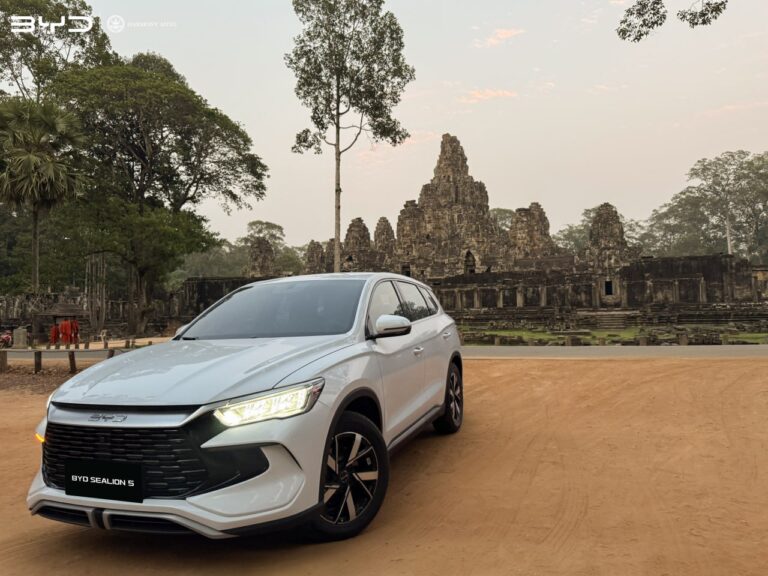Beyond Savings: Why Green EV Charging is Cambodia’s Smartest Investment

Beyond Savings: Why Green EV Charging is Cambodia’s Smartest Investment
Cambodia is quickly becoming a beacon of progress in Southeast Asia, with a growing economy and an increasingly aware population eager for sustainable solutions. Among these, electric vehicles (EVs) are rapidly gaining traction, offering a cleaner, quieter alternative to traditional combustion engines. Yet, while the immediate fuel savings of an EV are undeniably attractive, a deeper, more impactful benefit is emerging—the strategic smart investment that comes from powering these vehicles specifically with green energy in Cambodia.
This article goes beyond the obvious financial advantages to uncover why Green EV Charging in Cambodia represents a multifaceted smart investment. It delivers not only profound environmental benefits but also significant long-term economic gains, enhanced energy security, and an improved brand reputation for both individuals and businesses. Join us as we explore why embracing green EV charging isn’t just a good choice; it’s a strategic move for Cambodia’s sustainable future.
- Beyond Savings: Why Green EV Charging is Cambodia’s Smartest Investment
- 1. The Green Imperative: Why Your EV’s Power Source Truly Matters
- 2. Beyond the Pump: Unpacking the Economic Edge of Green EV Charging
- 3. Environmental Dividends: The True Zero-Emission Promise
- 4. Reputation & Resilience: Investing in Your Brand’s Sustainable Future
- 5. Making the Switch: Practicalities and Pathways in Cambodia
- Conclusion: Accelerating Cambodia’s Sustainable Leap with Green EV Charging
- Frequently Asked Questions (FAQs) About Green EV Charging in Cambodia
1. The Green Imperative: Why Your EV’s Power Source Truly Matters
The narrative around electric vehicles often focuses on their zero tailpipe emissions, presenting them as an inherently clean alternative. However, to truly understand an EV’s environmental footprint, we must consider its “well-to-wheel” emissions—the pollution generated from the production of electricity used to charge it. An EV is only as green as its energy source. If electricity comes from fossil fuel-heavy power plants, the overall environmental benefit is significantly diminished. This is where Green EV Charging in Cambodia makes a critical difference.
Cambodia is uniquely positioned for a truly green EV revolution. Unlike many nations still heavily reliant on fossil fuels for their electricity grid, Cambodia’s energy mix is progressively becoming cleaner. According to reports from the Ministry of Mines and Energy (MME) and Electricité du Cambodge (EDC), hydropower consistently accounts for a substantial 40-50% of the national generation capacity. More impressively, solar PV is rapidly expanding, contributing 10-15% by 2023/2024. The government has set ambitious targets to reach 70% renewable energy by 2030, reinforcing Cambodia’s commitment to a Cambodia’s Green Grid. This means that charging an EV from the national grid here already offers a cleaner profile than in many other countries.
However, the ultimate step towards “true zero” emissions lies in directly powering your EV with dedicated green energy sources, such as rooftop solar panels. As an environmental policy advisor in Phnom Penh aptly states, “An EV is only as green as its energy source. In Cambodia, with our rapidly expanding solar and hydro capacity, charging your EV with clean energy directly translates into a truly zero-emission journey, setting a new benchmark for sustainable transport.” This commitment to a clean energy source transforms a clean vehicle into a genuinely green solution.

2. Beyond the Pump: Unpacking the Economic Edge of Green EV Charging
While immediate fuel savings are often the primary motivator for switching to EVs, the economic benefits of Green EV Charging extend far beyond. For individuals and businesses alike, integrating renewable energy for EV charging represents a smart EV investment in Cambodia that yields significant long-term financial advantages.
One of the most compelling aspects is long-term energy cost predictability. By installing your own solar energy system, you essentially lock in your electricity costs for decades. This insulates you from the volatility of global fossil fuel prices and any potential increases in electricity tariffs. Research on the Cambodian market suggests that the typical payback period for commercial and industrial rooftop solar installations can be as attractive as 4-6 years, meaning businesses can enjoy virtually free energy for the remaining lifespan of their solar system, often 20-25 years. This stability is invaluable for strategic financial planning.
Furthermore, properties (both residential and commercial) with integrated solar EV charging solutions become significantly more valuable and attractive. They represent a modern, future-proof asset. For businesses, the operational savings are profound. Companies operating EV fleets—be it for logistics, ride-hailing services, or staff transport—can witness drastic reductions in “fuel” bills. For example, a local logistics company that equipped its warehouse with rooftop solar to power its urban delivery EV fleet reported substantial monthly savings on energy costs, significantly boosting their operational efficiency and profitability. This focus on solar EV ROI in Cambodia demonstrates a clear financial win. Beyond direct savings, the burgeoning green energy and EV sector also stimulates local job creation, from installation and maintenance to technological development.

3. Environmental Dividends: The True Zero-Emission Promise
The commitment to Green EV Charging unlocks the full environmental potential of electric vehicles, delivering tangible benefits that contribute directly to Cambodia’s sustainability goals. This goes beyond just reducing tailpipe emissions; it’s about achieving the maximum possible EV carbon footprint reduction in Cambodia.
By utilizing renewable sources like solar or hydropower for charging, we eliminate the indirect carbon emissions associated with electricity generation from fossil fuels. This pushes the “well-to-wheel” emissions to near zero, making the EV genuinely green. According to environmental impact assessments, each EV charged purely by solar power can effectively reduce carbon emissions by approximately 2-3 tons of CO2 per year compared to a gasoline car. As a renewable energy developer in Cambodia highlighted, “Each kilowatt-hour of solar energy used to charge an EV replaces a kilowatt-hour that might have come from a fossil fuel plant, creating a tangible reduction in our national carbon footprint.”
Beyond carbon, the environmental benefits extend to the cleaner air EVs help provide. Less reliance on fossil fuels for power plants translates to fewer emissions from industrial sources, significantly improving urban air quality and public health. This synergistic effect—cleaner vehicles powered by cleaner energy—creates a powerful positive loop for the environment. Moreover, it reduces the overall demand for finite fossil fuel resources, contributing to long-term global and national resource conservation. This holistic environmental impact of EV charging makes it a cornerstone of sustainable development.

4. Reputation & Resilience: Investing in Your Brand’s Sustainable Future
In today’s globalized economy, a company’s commitment to sustainability is no longer a niche concern but a crucial factor influencing consumer choices, investment decisions, and talent acquisition. For businesses and individuals alike, embracing Green EV Charging is a powerful statement, an investment in your brand’s future, and a pathway to increased resilience.
Businesses that proactively adopt green EV charging demonstrate a strong commitment to corporate social responsibility (CSR) and environmental stewardship. This resonates deeply with an increasingly eco-conscious consumer base, driving customer loyalty and attracting new clients who prioritize sustainable practices. It also provides a significant competitive advantage, differentiating businesses as leaders in sustainability within the Cambodian market, which is particularly vital for sectors with global supply chain considerations like manufacturing and tourism.
Moreover, investing in green EV charging significantly improves a company’s ESG (Environmental, Social, and Governance) ratings. Strong ESG performance is becoming critical for attracting international investment and meeting global sustainability benchmarks. As a corporate sustainability officer in Phnom Penh remarked, “Businesses that proactively invest in green EV charging aren’t just saving money; they’re investing in their brand’s future, appealing to a growing segment of environmentally aware customers and talent, and strengthening their ESG standing—a true smart investment.”
Furthermore, this commitment enhances energy independence for Cambodia. By reducing reliance on imported fossil fuels for both vehicles and electricity generation, green EV charging contributes directly to the nation’s broader energy security, fostering resilience against global energy market fluctuations.

5. Making the Switch: Practicalities and Pathways in Cambodia
The vision of Green EV Charging in Cambodia is becoming increasingly tangible, with practical solutions and supportive frameworks emerging across the kingdom. Making the switch is more accessible than ever before.
Cambodia’s renewable energy sector is expanding, bringing a growing ecosystem of local and international providers specializing in rooftop solar installations and comprehensive EV charging solutions. Companies like Solarity and other local solar providers are readily available to assess needs and install tailored systems for both residential and commercial properties.
Crucially, the financial landscape is also adapting. Individuals and businesses can access green loans in Cambodia from various local and international financial institutions. Major banks, such as ACLEDA Bank, are offering specific green loan products designed to facilitate investments in sustainable technologies, including solar energy systems that can power EV charging. These financing options significantly mitigate the initial capital investment, making the long-term ROI even more attractive.
While challenges like upfront capital costs and space requirements for larger solar setups exist, these are actively being addressed through innovative financing and technological advancements. The Cambodian government’s strong support, as evidenced by the National Policy on EV Development 2024-2030 and existing tax incentives for EVs, further creates a conducive environment. The increasing private sector involvement, from EV assembly plants to smart charging initiatives, signals a clear path forward. As a director of innovation at a Cambodian EV tech company put it, “The momentum is here. We are seeing innovative solutions emerging, from dedicated solar carports to smart grid initiatives that will ensure EVs are charged efficiently and cleanly, driving Cambodia’s green ambitions forward.”
Conclusion: Accelerating Cambodia’s Sustainable Leap with Green EV Charging
The journey of electric vehicles in Cambodia is evolving beyond mere fuel efficiency; it’s transforming into a strategic movement towards a deeply sustainable and economically robust future. Green EV charging—powering vehicles with clean, renewable energy—is proving to be Cambodia’s most intelligent investment. It delivers profound economic savings, maximizes environmental benefits, bolsters energy security, and significantly elevates brand reputation, all contributing to a more resilient and prosperous nation.
The synergy between Cambodia’s commitment to renewable energy and its burgeoning EV market presents a unique and compelling opportunity for individuals and businesses alike to lead the way in sustainable development. By embracing this powerful combination, we not only drive cleaner vehicles but also accelerate the growth of a greener, more independent energy sector.
We strongly encourage you to explore green EV charging solutions for your home or business. Connect with reliable providers, leverage the increasing availability of green financing options, and become an integral part of Cambodia’s cleaner, more sustainable future. The time to invest in a genuinely green tomorrow is now, and Cambodia is charging forward with purpose.
Frequently Asked Questions (FAQs) About Green EV Charging in Cambodia
- Q: What does “Green EV Charging” mean in the Cambodian context?
- A: It means charging your electric vehicle (EV) using electricity generated from renewable sources like solar power or Cambodia’s abundant hydropower. This ensures that the entire “well-to-wheel” process of your EV’s operation is as environmentally friendly as possible.
- Q: How can I access green energy for charging my EV at home or for my business?
- A: The most common way is to install rooftop solar panels on your property. There are also a growing number of public charging stations that are explicitly powered by renewable energy sources, often indicated by the provider.
- Q: What are the economic benefits of installing solar for EV charging beyond immediate savings?
- A: Beyond reduced electricity bills, you gain long-term cost predictability, protection from energy price volatility, increased property value, and, for businesses, enhanced corporate social responsibility (CSR) and improved ESG ratings.
- Q: Are there financial incentives or green loans available for setting up green EV charging solutions in Cambodia?
- A: Yes, several local and international financial institutions in Cambodia, such as ACLEDA Bank, offer specialized green loans designed to fund investments in renewable energy systems, including those used for EV charging.
- Q: How does green EV charging contribute to Cambodia’s national energy security?
- A: By utilizing domestically produced renewable energy for transportation, green EV charging reduces Cambodia’s reliance on imported fossil fuels for both vehicles and electricity generation, thus strengthening the nation’s energy independence and resilience.



